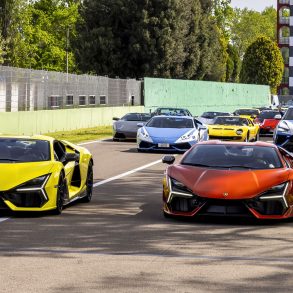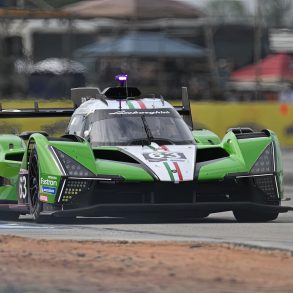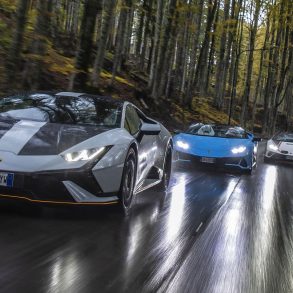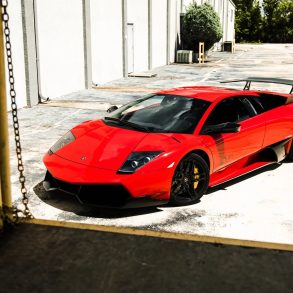Ever since the first automobiles span their wheels on the roads and the first planes gave humans the ability to conquer the skies, our primal fascination with speed has rapidly progressed to give us ultimate expressions of this machinery. A century later, supercars and fighter jets have established themselves as two sides of the same coin, epitomizing the latest technology employed to propel us to previously unfathomable speeds, on land or in air. If a jet fighter and a supercar had an offspring, it would have definitely been the Lamborghini Reventón.
Background
When it arrived as a concept car at the 2007 Frankfurt Motor Show, the Lamborghini Reventón was the utmost evolution of the Murcielago, an iconic mid-2000s supercar that defined the rebirth of Lamborghini under Volkswagen AG. This fighter jet on wheels was a new high point from Sant’Agata Bolognese and we are here to do a quick round-up of how and why it happened.

In its history, Lamborghini committed to both revolution and evolution. When the Miura arrived in 1966, the concept of a transversely-mounted V12 in a production car caused a stir so big it infuriated Enzo Ferrari, making him rethink the whole Ferrari line-up, thus changing the world of supercars forever.

Next was the Countach, a radical wedge-shaped masterpiece by Marcello Gandini, which became a car so iconic it pushed dozens of other contemporary Lamborghinis into obscurity. While literally everyone remembers or at least recognizes the Countach when they see one, only a small circle of car lovers will know a thing or two about the Jalpa, the Urraco, or the Silhouette. During its 16-year reign, the Countach epitomized everything one supercar should be and it will probably remain the most iconic Lamborghini of all times.
After the Countach, Lamborghini relied on evolution, with the Diablo and the Murciélago following the same basic engine architecture and wedge shape as the Countach, albeit modernized and perfected. The Reventón was a product of that evolution, the latest world in the Murciélago evolutive process and the announcement of the next Lamborghini supercar to come.

Development of the Reventón
Envisioned as the ultimate Murciélago LP 640, the Reventón didn’t follow a lengthy and complex development process. Historically, Lamborghini produced special variants to say goodbye to its then-current flagship supercar.

The Miura had the P400 SV/J, while the Countach was given a 25th Anniversary Edition. When the Diablo was ready to go, the company released a Diablo VT 6.0 SE limited to 42 units. This special edition was offered in two colors, Oro Elios and Marrone Eklipsis, representing the Sun’s life cycle by referring to sunrise and sunset respectively.
However the Murciélago’s arrivederci went a step ahead. While the previous send-off editions were still carrying the names of their respective models, the final Murciélago was given a new name and radical design anticipating the new direction for Lamborghini’s breed of V12-powered supercars.
Borrowing from bullfighting tradition, the Reventón was named after a Mexican bull known for killing the famous matador Felix Guzman. The name itself can be interpreted as an explosion or a flower in full bloom. Whatever way you want to interpret it, it can be applied to the Reventón, an energetic supercar representing the final stages of the Murciélago development.

The Reventón debuted as a concept at the 2007 Frankfurt Auto Show and Lamborghini soon confirmed that it will go into limited production of 21 copies. The 00/20 was set to stay in the Museo Lamborghini in Sant’Agata Bolognese, while the remaining twenty were instantly sold to the most dedicated clients and collectors at $1.42 million each.
In 2009, alongside the LP670 SuperVeloce which finally waved goodbye to the Murciélago nameplate, Lamborghini announced the Reventón Roadster, a limited run of ‘less than 20’ open-top copies. This variant met even greater demand and all examples were sold within minutes. The number of these open top stunners is believed to be 15 with only three RHD examples built.

Lamborghini Reventón Chassis
The Reventón borrowed the construction from the Murciélago LP 640, meaning that the occupants were cocooned around a steel tubular frame with honeycomb carbon fiber elements glued and riveted to it, a steel roof and carbon fiber floorpan. This chassis enabled low placement of the massive V12 paired up with incredible structural rigidity and the Reventón benefitted from the same construction.
The Reventón was the last Lamborghini supercar to utilize this type of construction. The next generation V12 car utilized a full carbon-fiber monocoque rolling chassis with extensive use of carbon fiber reinforced plastic.
Body – Razor Sharp Lines
As previously stated, fighter jet aesthetics was a dominant inspiration for Centro Stile Lamborghini when creating the Reventón. Moreover, razor-sharp polygonal shapes always worked better for the Italian company than softening the edges, thus diluting the brand identity.

With that in mind, the basic proportions of the Murciélago were simplified and made more aggressive thanks to extensive use of straight lines and geometric shapes. Every curve of the Murciélago was brushed and made knifelike, only to be reduced to a set of contorted flat surfaces.
The fascia of the Reventón received a more aggressive look with an arrow-like central section and two protruding air intakes, whereas the lights have been reduced to a sharp, almost triangular shape.

The glass panel offering a glimpse of the V12 was constructed in three arrow-like layers of laminated glass and the theme continued to the very rear of the car. The rear section of the Reventón got an aggressive diffuser and a huge hexagonal centrally mounted exhaust. Of course, the doors opened upwards, in true Lamborghini fashion ever since the iconic Countach.
![rear lights of Lamborghini Reventón ]](https://cdn.sportscardigest.com/wp-content/uploads/20201126140154/2008-Lamborghini-Reventon-_1-1-750x500.jpg)
If you look closely, you’ll notice that the Reventón is actually asymmetrical; the side vents positioned in front of the rear wheels have noticeably different designs and that feature is not just for show. The prominent intake on the driver’s side is there to increase the flow of oil to the radiator. On the passenger’s side, however, the intake is flat because its only function is to keep the air flowing below the Reventón’s floor.
Compared to the Reventón, the LP670-4 seemed almost serene, and that’s a bold statement considering the fact that every Murciélago is pure drama on wheels.

Unlike the Murciélago which used a combination of steel, carbon fiber and aluminum, the Reventón’s lightweight body was constructed in carbon fiber and finished in Reventón, a military-inspired dark matte grey with a hint of green and a special depth of color in the sunlight thanks to metallic particles in the mix. In this special shade, all the revisions and updates stood out while also giving the stealth fighter look to the supercar. The only shiny exterior details were the wheels finished in a combination of gloss black aluminum and naked carbon fiber panels..
Just like the coupé, the Lamborghini Reventón Roadster carried the same geometric design cues, but was painted in a somewhat lighter shade named simply Reventón Grey.
Interior of the Lamborghini Reventon
In lieu of its stealth fighter look, the cockpit of the Reventón was also given extremely exceptional treatment. Military-inspired olive green and sand yellow Alcantara dominated the cabin of the supercar alongside exposed carbon fiber weave and touches of aluminum and high-quality soft leather.

The racy seats mirror the outside design with the same triangular theme and pointy shapes, most notably on the seating portion of the buckets. The outside portions of the seats are wrapped in gloss leather, while decorated Alcantara is used for the middle section. As another military detail, the name Reventón was written in stencil-like caps on the door cards and on an ID tag nestled between the two seats.
Further differentiating the Reventón from the Murciélago was a modern instrument cluster. Housed inside an element made out of a solid aluminum block and wrapped in carbon fiber, the cluster featured three LCD screens providing the driver with vital information.

The design of the displays was also inspired by military aeronautics. On a top-mounted display, the Reventón featured the G-Force-Meter showing longitudinal and transversal forces represented by the movement of a dot-like indicator moving on a graduated 3D grid. The jet-like digital display showed linear progression through the rev and speed, epitomizing the airforce pilots’ experience. At the touch of a button, the display could be changed to a more traditional one, albeit with a unique design and bullet-like markers on the dials.
Engine and Transmission
Having been based on the Lamborghini Murciélago LP 640, the Reventón retained the same engine displacement, power output, and performance figures as its foundation. Still, the numbers were quite impressive and nobody really cared that the Reventón didn’t bring anything new performance-wise.

The powerhouse in question was a 6.5-liter 60° V12 boasting 640 horsepower at screaming 8000 RPM and 486 lb-ft of torque. The jump in horsepower from the original 580 to 640 was achieved via a thorough revision of virtually every component inside and around the engine.
The V12 benefited from a new crankshaft and camshafts, variable engine geometry, and drive-by-wire engine management. Next, the air inlets also used variable geometry to ensure optimal airflow at any speed and outside temperature, and the oil radiator was considerably enlarged to cope with the additional heat generated by the more potent engine.

Having the same V12 unit positioned behind the occupants, the Reventón was able to sprint from a standstill to 60 MPH in 3.4 seconds with a top speed of 211 MPH.
On the other hand, the Reventón Roadster was based on the even more powerful LP 670 SuperVeloce, hence more horsepower, 670 to be precise, but its top speed was slightly lower at 205 MPH.
Both engine variants were mated to 6-speed e-gear automated manual, a costly optional extra on the Murciélago LP 640.
The unique construction of the Lamborghini V12 places the transmission in front of the engine while the rear differential is integrated into it, while the viscous coupling center differential sends the power to the front wheels. In regular driving condition, the Lamborghini Viscous Traction all-wheel drive gives 70:30 rear-biased power balance.
Suspension
The Reventón inherited a revised suspension from the Murciélago LP 640 ensuring balance and superb mechanical grip combined with daily usability thanks to features helping the low-slung car to survive everyday traffic.
The suspension system consists of independent double wishbones with steel arms and hydraulic shock absorbers. Both front and rear, springs and dampers are mounted coaxially. Each front wheel has a single spring whereas two springs are controlling the movement of each rear wheel.
To further balance the Reventón during cornering, anti-dive and anti-squat were carried over from the Murciélago as well.
Finally, there’s the hydraulic lift system used to help the ultra-low Reventón go over speed bumps or steep driveways. The system uses hydraulic from the steering wheel to lift the front end of the car around 50mm, enough for the supercar to go over the obstacle.
Brakes, Wheels and Tires
When it came to stopping power, the Reventón was given the latest word on what Lamborghini had to offer in 2007. Optional extras on the LP 640, the 380 mm carbon-ceramic brakes with six-piston brake calipers were standard on the limited-edition supercar, ensuring superb control and durability, but also keeping up with the stealth airplane visual identity.

The wheel size remained the same as on the LP 640 (18×8.5 front and 18×13 back), but the Reventón was given a unique turbine effect five-spoke wheel design with carbon fiber fins screwed onto the aluminum spokes. With that in mind, the razor-sharp alloys wear Pirelli P Zero Corsa 245/35 ZR 18 in the front and 335/30 ZR 18 tires in the back.
Legacy
History has shown us that cars built in limited numbers often display a surge in price sooner or later, especially if the cars in question are produced in double digits. The other rule of limited collector cars tells us that the fewer the production numbers and the higher the sticker price, the flatter is the curve between the initial depreciation and subsequent appreciation.

That might lead you to think that the Reventón started appreciating from the first day on the market, because who wouldn’t want a one-of-twenty fighter jet on wheels? Apparently, not enough people, at least not on the collector car markets. While the cars were sold out instantly when they appeared in 2007 and 2009, the market for them as collector cars just shrunk in the following years. The reasons for that are unknown, but the numbers don’t lie: the prices of rare Reventóns on the market are usually lower than their MSRP.
Whatever the reason, the Reventón fulfilled its main purpose, to showcase the future of Lamborghini. Announcing the Murciélago’s successor, the Reventón prepared us for the design we witnessed on the Aventador, the current signature Lamborghini. More than a few features were carried over from the Reventón to the sharper, more defined, and more advanced supercar.

In addition to that, the Reventón also opened the door for more limited production and one-off Lamborghinis based on the Aventador. The Veneno, the Centenario, the Sian and the Essenza SCV12 are altogether directly influenced by what Reventón has done in 2007.
Regardless of its underwhelming performance as a collector car, the Reventón stands among the most influential modern day Lamborghinis and it will surely be better recognized as a pivotal force within the beloved Sant’Agata Bolognese factory.










